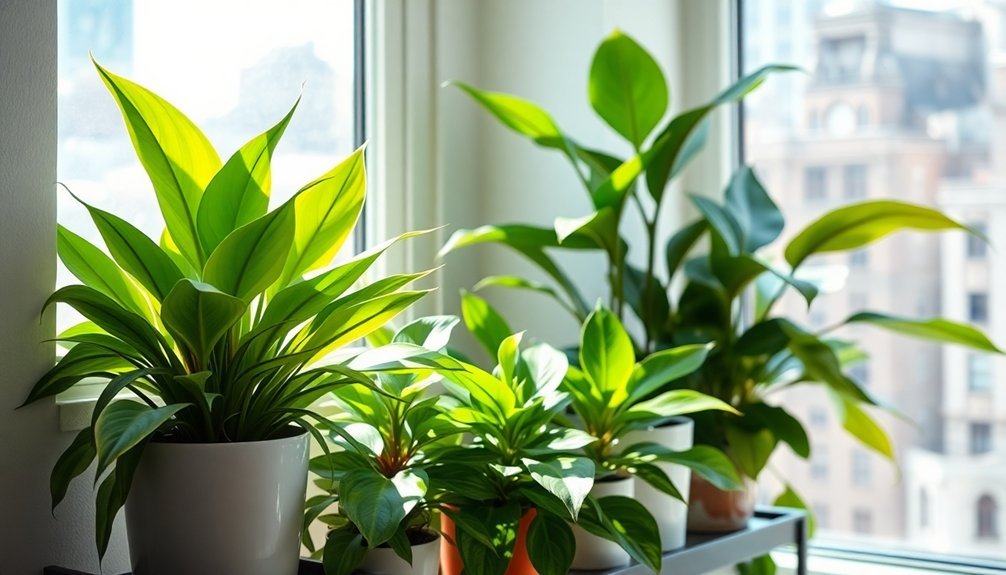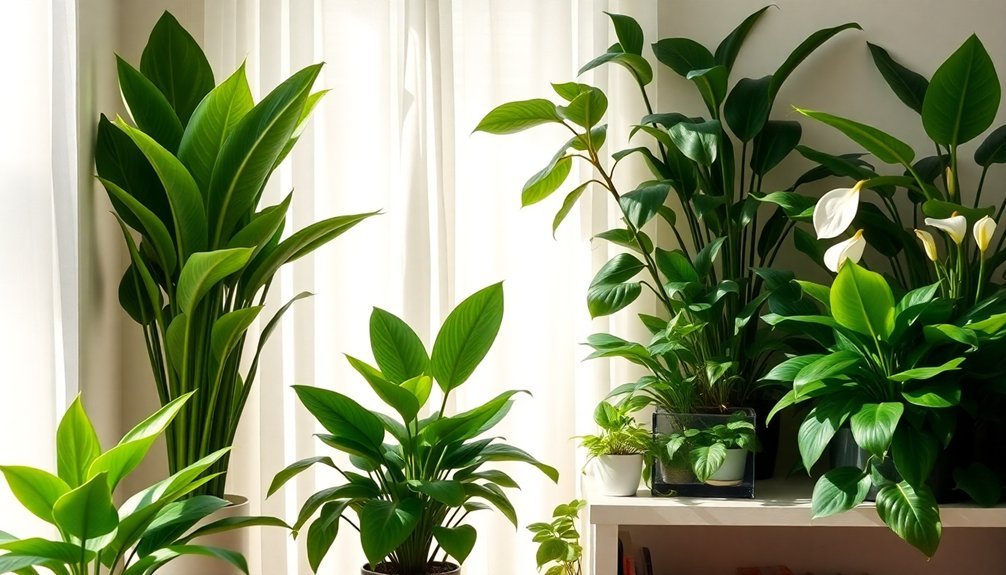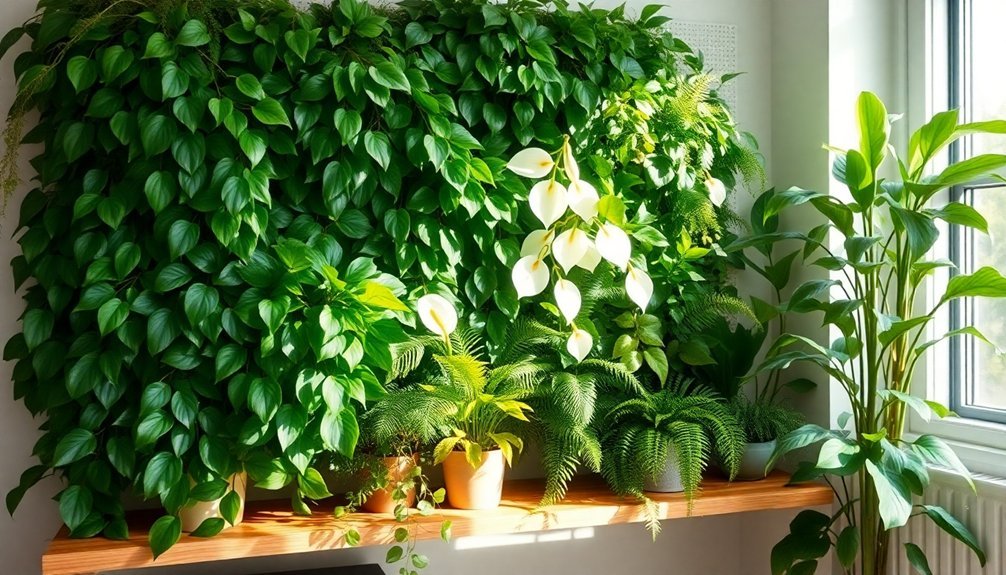For tight living spaces, choose compact air-purifying champions like the Snake Plant, which removes 50% of pollutants within 48 hours, or the low-maintenance ZZ Plant that thrives in dim corners. Peace Lilies and Spider Plants effectively filter toxins while taking up minimal space in hanging baskets or wall planters. You'll also love the adaptable Golden Pothos for its ability to clean air from any perch. Discover how these green warriors can transform your small space into a refreshing atmosphere.
Understanding Indoor Air Pollutants and VOCs

While most people focus on outdoor air pollution, indoor air quality can pose an even greater health risk since we spend roughly 90% of our time inside.
Your home likely contains two major types of air pollutants: combustion pollutants and volatile organic compounds (VOCs).
Combustion pollutants come from burning materials and include carbon monoxide from fuel-burning appliances, nitrogen dioxide from gas stoves, and particulate matter from wood burning. Indoor plants have seen a 7% annual growth in sales as people seek natural solutions for cleaner air.
VOCs, on the other hand, lurk in everyday items like pressed wood furniture, paints, and cleaning supplies. These pollutants can trigger serious health issues, from respiratory problems and asthma to cardiovascular complications.
You'll find VOCs are particularly sneaky – they're emitted from building materials, furniture, and even some adhesives, making them a persistent concern in tight living spaces.
Top Space-Saving Plants That Filter Indoor Air
Vertical growing solutions let you maximize your limited space while enjoying the air-purifying benefits of trailing plants like English Ivy and Golden Pothos.
These plants actively engage in phytoremediation processes to remove harmful toxins from your indoor environment.
You'll get the most air-filtering power by mounting these plants in wall planters or hanging baskets, allowing their vines to create natural curtains of greenery.
Space-conscious varieties such as Snake Plants and ZZ Plants offer similar air-cleaning capabilities while maintaining a compact, upright growth pattern that won't sprawl across your surfaces.
Vertical Growing Solutions
As urban dwellers seek efficient ways to purify their indoor air, space-saving vertical gardens offer an innovative solution that combines aesthetics with functionality.
You'll find that spider plants, peace lilies, and snake plants are particularly effective at removing harmful pollutants like formaldehyde and benzene while requiring minimal horizontal space.
Modern vertical gardening systems make maintenance easier with automated features that monitor plant health and adjust nutrients. Proper air circulation systems ensure your plants receive consistent airflow, preventing stagnation and promoting optimal growth.
You can install sensors that track your plants' well-being and optimize their growing conditions in real-time.
These smart systems guarantee your air-purifying plants thrive with minimal effort on your part.
Beyond air purification, your vertical garden will help regulate indoor temperature, reduce energy costs, and create a natural habitat for beneficial insects, making it a truly sustainable choice for tight living spaces.
Space-Maximizing Plant Varieties
Building on the success of vertical gardening, specific plant varieties offer remarkable air-purifying benefits while taking up minimal space.
You'll find that compact plants like the Snake Plant and Peace Lily excel at removing multiple toxins while fitting perfectly in small areas. These space-smart options don't compromise on air-cleaning power.
For maximum space efficiency, consider these top performers:
- Spider Plants in hanging baskets, which remove pollutants while producing offspring plants
- Compact Aloe Vera, which filters formaldehyde and benzene while offering medicinal benefits
- Peace Lilies in small pots, eliminating five major toxins while adding elegant white blooms
- English Ivy, which can be trained to grow vertically while removing three harmful chemicals
These varieties guarantee you won't have to choose between clean air and precious floor space.
Small but Mighty: Snake Plant's Air-Cleaning Power

Every home could benefit from a snake plant's remarkable air-purifying abilities. In just 48 hours, you'll notice cleaner air as this powerful plant removes over 50% of common pollutants like formaldehyde, benzene, and trichloroethylene. While you sleep, it's continuously producing oxygen and absorbing over 100 different toxins through its leaves.
| Variety | Light Needs | Best Features |
|---|---|---|
| Golden Snake | 5-6 hrs indirect | Classic yellow edges |
| Green Snake | Adapts to low light | Silver-sage stripes |
| Dwarf Types | Any light condition | Space-saving size |
| Twisted Leaf | Bright indirect | Unique wavy form |
You'll find these plants incredibly easy to maintain – they're forgiving with light conditions and can thrive with minimal water. Their ability to combat "Sick Building Syndrome" while requiring little care makes them perfect for busy households.
ZZ Plant: The Low-Light Air Purification Champion
Your ZZ plant doesn't just survive in low-light spaces – it actively purifies your air while requiring minimal attention from you.
These resilient plants use their waxy leaves and extensive root systems to trap and break down harmful indoor pollutants like benzene and formaldehyde, even in dimly lit corners of your home.
You'll appreciate how the ZZ plant's natural toxin-fighting abilities work continuously through its leaves and soil microorganisms, making it an ideal choice for busy urbanites seeking cleaner air in tight spaces.
Thrives Without Natural Light
While many houseplants struggle in low-light conditions, the ZZ Plant stands out as a remarkable air purifier that thrives even without natural sunlight. You can place it in spaces with minimal lighting, like windowless offices or dark corners, where it'll continue to filter harmful toxins from the air.
This adaptable plant excels in various lighting conditions, making it perfect for your indoor spaces:
- Survives with just overhead lighting
- Tolerates partial shade or even darkness
- Functions with as little as 12 hours of artificial light
- Maintains air-purifying abilities in low light
You'll find the ZZ Plant particularly useful in basements, offices, or any room lacking natural light. It effectively removes toxins like formaldehyde, xylene, and benzene while requiring minimal maintenance, making it an ideal choice for busy households.
Minimal Care, Maximum Benefits
Despite its powerful air-purifying abilities, the ZZ Plant demands remarkably little attention to thrive in your home.
You'll only need to water it once a week or less, allowing the soil to dry completely between sessions. This hardy plant won't suffer if you forget to water it occasionally, making it perfect if you're frequently away.
While it's busy removing harmful toxins like xylene, toluene, and benzene from your air, the ZZ Plant requires virtually no maintenance.
You won't need special fertilizers, humidity controls, or frequent pruning. Its glossy leaves stay attractive with minimal care, and its compact size lets you place it anywhere from your bedroom to your office.
Best of all, it's highly resistant to pests and diseases, so you can enjoy its air-purifying benefits without worrying about complex care routines.
Toxin-Fighting Growth Patterns
The ZZ Plant's remarkable air-purifying abilities stem from its sophisticated toxin-fighting mechanisms. Its thick, waxy leaves and extensive root system work together to trap and break down harmful VOCs like benzene and formaldehyde.
You'll find that the plant's effectiveness doesn't diminish even in low-light conditions, making it perfect for darker corners of your home.
The real magic happens in the rhizosphere, where beneficial microorganisms collaborate with the plant's natural processes to neutralize toxins.
Here's how the ZZ plant fights air pollution:
- Absorbs VOCs through both leaves and roots
- Converts toxic compounds into harmless substances through enzymatic reactions
- Maintains effectiveness regardless of light conditions
- Partners with soil microbes to break down pollutants more efficiently
This scientifically-proven air purifier thrives with minimal attention while consistently cleaning your indoor air.
Compact Air Cleaners: Peace Lily for Tight Corners

Peace lilies stand out as one of nature's most efficient air purifiers for compact spaces.
These versatile plants can remove up to 23% of trichloroethylene from your indoor air within 24 hours, while also tackling benzene, formaldehyde, and other harmful pollutants.
You'll find peace lilies particularly suitable for tight corners, as they thrive in low light conditions and grow between one and four feet tall.
They're easy to maintain – just avoid overwatering and provide indirect light.
To maximize their air-cleaning power, trim the lowest leaves to expose more soil surface area.
While you'd need multiple plants for significant air quality improvement in larger spaces, even a single peace lily can make a difference in small, enclosed areas.
Plus, you'll enjoy added benefits like increased humidity and reduced dust levels.
Vertical Solutions: Growing Air-Purifying Plants Upward
Transform your limited wall space into an air-purifying oasis by mounting a living wall system, which can accommodate multiple plant varieties in a structured grid pattern.
You'll maximize your vertical space with tiered hanging planters that create cascading levels of air-filtering greenery, perfect for compact rooms and tight corners.
Support your climbing plants with trellises or wire systems attached to the wall, allowing vines to naturally grow upward while cleaning your air.
Living Wall Design Basics
When space comes at a premium, vertical gardening offers an innovative solution for growing air-purifying plants.
You'll need to start with a solid plan, considering both wall stability and proper irrigation. Your wall can support 5-20 pounds per square foot when saturated, so choose mounting hardware carefully, favoring butterfly screws over expanding anchors.
For ideal air-purification benefits, select plants with:
- Large leaf surfaces like Dracaena and Pothos
- Year-round performance from evergreen varieties
- Proven air-cleaning abilities such as Snake Plant and English Ivy
- Adaptability to your specific climate zone
Design your layout using a simple diagram with colored markers to map plant placement.
Remember to integrate an automatic watering system with drip lines for consistent moisture. Don't rely on rainfall alone, as it won't provide adequate hydration for your vertical garden.
Hanging Planter Space Optimization
Building upon the concept of vertical gardening, hanging planters offer another space-saving strategy for maximizing your air-purifying plant collection.
You'll find spider plants, English ivy, pothos, and philodendrons particularly well-suited for overhead placement, as they naturally cascade and thrive in hanging environments.
Choose your plants based on your space's lighting conditions. If you're working with low light, opt for pothos or English ivy. For brighter areas, spider plants will flourish.
All these varieties effectively remove common indoor toxins like formaldehyde and xylene while creating an appealing vertical display.
To maintain your hanging garden, establish a consistent care routine. Water your plants when the soil's top layer feels dry, and trim occasionally to control growth and maintain their attractive trailing appearance.
This approach maximizes both air purification and aesthetic benefits.
Climbing Plant Support Systems
Stainless steel climbing support systems offer a robust foundation for growing air-purifying plants vertically in tight spaces.
With marine-grade materials that meet AISI 316 standards, you'll get a weather-resistant structure that's perfect for both indoor and outdoor environments.
You can easily install these versatile systems on various wall types using basic tools, making them ideal for DIY projects.
The modern design features make these systems particularly attractive for contemporary living spaces, while their practicality shines through with low maintenance requirements.
Here's what makes these support systems perfect for air-purifying plants:
- UV-resistant components guarantee long-lasting durability
- Adaptable configurations fit spaces from 4 to 38 inches wide
- Easy installation with minimal tools required
- Supports healthy growth of air-cleaning climbers like jasmine
Scientific Evidence Behind Plant Air Filtration

Through decades of scientific research, including groundbreaking studies by NASA, we've gained substantial evidence supporting plants' ability to purify indoor air.
You'll find that most of the air-cleaning action happens in the root zone, where soil microorganisms break down pollutants and convert them into plant tissue.
NASA's experiments in sealed chambers have shown that plants can continuously remove VOCs from the air, while research at Biosphere 2 demonstrated their effectiveness in maintaining air quality.
You'll get even better results using hydroculture systems, which are 30-50% more effective than traditional potting soil.
When you combine plants with activated carbon filters and mechanical fans, you'll maximize their air-purifying potential.
The best part? These natural air purifiers work without electricity and provide aesthetic benefits while cleaning your air.
Maintenance Tips for Indoor Air-Cleaning Plants
Keeping your air-purifying plants healthy requires consistent but straightforward maintenance routines. Regular cleaning, pest control, and proper watering guarantee your plants continue filtering indoor air effectively.
To maintain your air-purifying plants' health, you'll need to check them weekly for dust buildup and pests. Use a damp microfiber cloth for larger leaves or a spray bottle for more delicate ones. When you spot pest problems, isolate affected plants immediately and treat them with insecticidal soap or rubbing alcohol.
Essential care practices include:
- Pruning yellowed leaves with clean Niwaki snips or scissors
- Checking soil moisture before watering to prevent root rot
- Wiping dust from leaves monthly to maximize air filtration
- Maintaining proper humidity levels, especially for moisture-loving plants like Boston Ferns
Maximizing Air Purification in Limited Square Footage

Living in a compact space shouldn't limit your ability to enjoy cleaner air. To maximize air purification in your small space, focus on strategic plant placement and selection.
Utilize vertical space by hanging Spider Plants or Pothos, and place low-light tolerant plants like Snake Plants and ZZ Plants in corners where natural light is limited.
Create a layered arrangement by combining floor plants with hanging varieties, and group multiple plants together for enhanced air-cleaning effects.
You'll get the best results by pairing your plants with an air purifier – they'll work together to remove different types of pollutants.
Place sun-loving plants like Aloe Vera near windows, and use humidity-tolerant options like Peace Lily in your bathroom.
This all-encompassing approach guarantees you're making the most of every square foot.
Selecting the Right Air-Purifying Plant for Your Space
When choosing an air-purifying plant for your space, several key factors will determine your success: available light, your experience level, and whether you have pets.
For areas with limited natural light, you'll find great options in the Golden Pothos, ZZ Plant, or Peace Lily, which all thrive in low-light conditions while effectively removing common pollutants.
If you're new to plant care, focus on these beginner-friendly options:
- Spider Plant: resilient and effective against xylene
- Golden Pothos: adaptable and removes multiple toxins
- ZZ Plant: drought-tolerant and low-maintenance
- Snake Plant: requires minimal care while purifying air
For pet owners, safety is essential. Consider the Areca Palm or Spider Plant, which offer excellent air purification while being non-toxic to your furry friends.
Creating an Air-Filtering Green Wall System

Taking air purification to the next level, green wall systems offer a sophisticated approach to cleaner indoor air while maximizing limited space.
You'll find that modern systems like Naava use active airflow technology, drawing air through plant root zones to remove up to 57% of VOCs in a single pass.
These automated systems don't just purify air—they're multifunctional solutions for your space. You can use them as room dividers or even whiteboards while they work continuously to clean your air.
With built-in sensors monitoring plant health and air quality, you won't need to worry about maintenance. They'll also help regulate humidity and temperature, potentially lowering your energy costs.
Whether you're furnishing a home office or studio apartment, these vertical gardens provide an efficient, space-saving way to breathe cleaner air.
Frequently Asked Questions
Can Air-Purifying Plants Trigger Allergies or Worsen Existing Respiratory Conditions?
Yes, you'll find that air-purifying plants can trigger allergies through their pollen, mold spores, and sap. If you have respiratory conditions, certain plants like weeping fig and peace lily may worsen your symptoms.
How Many Plants Are Needed per Square Foot for Effective Air Purification?
You'll need at least two good-sized plants per 100 square feet for basic air purification. For best results, you can double that number, especially if you're using larger, leafier plants with exposed soil.
Do Air-Purifying Plants Lose Their Effectiveness During Winter Months?
Your air-purifying plants maintain effectiveness in winter if properly cared for. You'll need to guarantee adequate light, consistent watering, and regular leaf dusting. They'll work best when you maintain ideal humidity levels.
Which Air-Purifying Plants Are Best for Bathrooms With High Humidity?
You'll get excellent air purification in your humid bathroom with Peace Lilies, Snake Plants, and Pothos. They'll thrive in the moisture while removing toxins, and they're easy to maintain year-round.
Can These Plants Remove Cigarette Smoke Odors Completely From Small Spaces?
While these plants can help reduce cigarette smoke odors, they won't eliminate them completely. You'll get better results by combining plants with air purifiers and ensuring proper ventilation in your small space.
In Summary
You're now equipped to transform your small living space into a naturally purified sanctuary. By selecting the right compact air-cleaning plants like snake plants, ZZ plants, or peace lilies, you'll improve your indoor air quality while adding natural beauty. Remember to match your plant choices with your available light and space, and you'll soon enjoy fresher, cleaner air in even the tightest quarters.
References
- https://filti.com/best-houseplants-for-clean-air-at-home/
- https://www.accuweather.com/en/weather-news/5-low-maintenance-plants-that-can-purify-the-air-in-your-home-office/432205
- https://tula.house/blogs/plant-reads/breathe-easy-5-air-purifying-plants-for-healthy-home
- https://www.wagnergreenhouses.com/blog/top-10-best-air-purifying-houseplants/
- https://homegarden.cahnr.uconn.edu/factsheets/houseplants-for-healthier-indoor-air/
- https://www.epa.gov/report-environment/indoor-air-quality
- https://www.co2meter.com/blogs/news/nasa-compiles-list-of-best-plants-to-clean-indoor-air
- https://ww2.arb.ca.gov/resources/documents/combustion-pollutants-indoor-air-quality
- https://www.niehs.nih.gov/health/topics/agents/indoor-air
- https://www.idyl.co.in/blogs/blog/breathe-easy-the-best-indoor-plants-for-clean-air-in-small-spaces





Leave a Reply